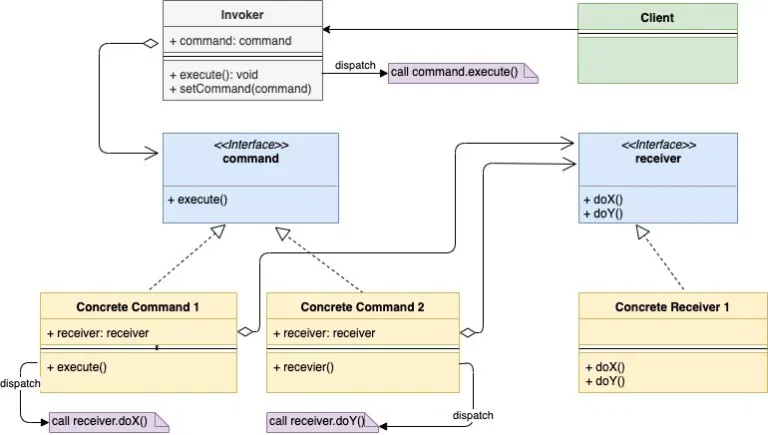介绍
命令(Command)模式是一种对象的行为型模式,类似于传统程序设计方法中的回调机制,它将一个请求封装为一个对象,从而使得可用不同的请求对客户进行参数化;对请求排队或者记录请求日志,以及支持可撤销的操作。命令模式是对命令的封装,将发出命令的责任和执行命令的责任分割开,委派给不同的对象,以实现发送者和接收者完全解耦,提供更大的灵活性和可扩展性。
命令设计模式中使用的基本组件包括:
- Receiver - 接受者,它是包含业务逻辑,处理最终的业务
- Command - 命令,被调用者所调用,包含了基本的执行命令
- Invoker - 调用者,调用命令
- Client - 用户,组装命令和接受者对象
看UML图最直观了

简单的UML图

例子
假设电视机上有两个按钮,每个按钮的功能是打开和关闭电视,对应于Command模式中的组件关系是:
Receiver - 电视机,电视机的开启和关闭
Command - 开关命令
Invoker - 按钮,有按钮发起开关命令
Client - 用户,看电视的人
对应代码关系如下:
| 组件 | 代码 |
|---|---|
| Invoker | button.go |
| Command Interface | command.go |
| Concrete Command 1 | onCommand.go |
| Concrete Command 2 | offCommand.go |
| Receiver Interface | device.go |
| Concrete Receiver | tv.go |
| Client | main.go |
代码
button.go
package main
type button struct {
command command
}
func (b *button) press() {
b.command.execute()
}
command.go
package main
type command interface {
execute()
}
onCommand.go
package main
type onCommand struct {
device device
}
func (c *onCommand) execute() {
c.device.on()
}
offCommand.go
package main
type offCommand struct {
device device
}
func (c *offCommand) execute() {
c.device.off()
}
device.go
package main
type device interface {
on()
off()
}
tv.go
package main
import "fmt"
type tv struct {
isRunning bool
}
func (t *tv) on() {
t.isRunning = true
fmt.Println("Turning tv on")
}
func (t *tv) off() {
t.isRunning = false
fmt.Println("Turning tv off")
}
main.go
package main
func main() {
tv := &tv{}
onCommand := &onCommand{
device: tv,
}
offCommand := &offCommand{
device: tv,
}
onButton := &button{
command: onCommand,
}
onButton.press()
offButton := &button{
command: offCommand,
}
offButton.press()
}
Output:
Turning tv on
Turning tv off
完整代码:
package main
import "fmt"
type button struct {
command command
}
func (b *button) press() {
b.command.execute()
}
type command interface {
execute()
}
type offCommand struct {
device device
}
func (c *offCommand) execute() {
c.device.off()
}
type onCommand struct {
device device
}
func (c *onCommand) execute() {
c.device.on()
}
type device interface {
on()
off()
}
type tv struct {
isRunning bool
}
func (t *tv) on() {
t.isRunning = true
fmt.Println("Turning tv on")
}
func (t *tv) off() {
t.isRunning = false
fmt.Println("Turning tv off")
}
func main() {
tv := &tv{}
onCommand := &onCommand{
device: tv,
}
offCommand := &offCommand{
device: tv,
}
onButton := &button{
command: onCommand,
}
onButton.press()
offButton := &button{
command: offCommand,
}
offButton.press()
}